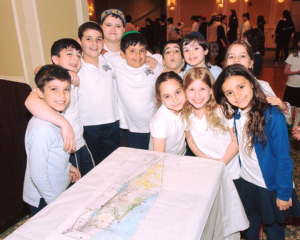Set against the backdrop of a hostile era that was characterized by political and cultural unrest, war, rebellion, and the loss of our nation’s great leader, the 1960s was the setting for my early childhood. It was a time when being different was “in.” Challenging convention was the standard amongst our country’s youth, and family values were precariously poised amidst a mentality that seemed to devalue all that was traditional, customary, and cherished. Paradoxically it was during the climate of this time, that the Ocean Parkway Jewish Center was the setting where the first seeds of my Jewishness were planted. Too young to be aware of all the unrest around me, in stark contrast, my world was a safe one. I attribute this in very large part to the tradition and structure with which I was raised to be a Jew.
My world included attendance at daily pre-school, where I quickly learned (and can still remember) my morot’s names, Jewish songs, and simple prayers. I made Jewish crafts on holidays, learned how to bake challah, shape hamantashen, and fry latkes. I even played the role of Queen Esther at the age of four in a Purim play (albeit after much coaxing and stage-fright, as I recall…). In total, my days at Ocean Parkway helped me to become familiar with life as a Jewish child in America. When my parents enrolled me at the Brooklyn Yiddish Academy, my days took on even more of a deep connection to my family’s roots. Twice a week I attended a small class of students led by Mrs. Gotnick, an Eastern European Holocaust survivor, whose mission upon her arrival in America two decades before was to carry on the traditions of her ancestors, including the language of her family in the shtetl from which only a few survived. It was in her little classroom (that always smelled like old wood and lemon oil…she used to polish the desks daily) on Eastern Parkway that I was given my first Yiddish reader, featuring Motel and Gittel in Shul (the Yiddish counterpart to Dick and Jane, I suppose…); it was where I learned “Lomeh Zingt a Yiddish Lid”–“Let me Sing a Yiddish Song,” and where I became familiar with the sounds, intonations, and very essence of the language of my father’s childhood in Sosonowiec, Poland, and my maternal grandmother’s youth in Dvinsk, Russia. I learned to understand many of the words that passed through my Brooklyn home between relatives, and the fabric of my early years was woven with a deep appreciation of the tongue with which my relatives spoke their first words. My father, in particular, always emphasized that Polish was the language that they spoke “when they simply had to…” to the Gentiles in town and in business. But Yiddish was their heart and their root, and hearing my father speak Yiddish filled me with a special warmth and wish to learn his language. And, so I did. My pre-school time was my introduction to our heritage. When we moved from Brooklyn to Long Island in 1968 in a still turbulent time (we moved boxes and set up our new home the very week that Dr. Martin Luther King was assassinated), I quickly learned that Mrs. Gotnick had opened a second school near our new home and that I would be continuing to learn with her. I was later enrolled in Hebrew school in our new synagogue, Temple Gates of Zion, where learning the ancient language of the Hebrew people replaced the Yiddish I had learned for so long. So, throughout the elementary, middle school, and high school years, my Jewish education and the synagogue were central in my life.
How was this strong sense of self as a Jew developed? I daresay that despite the marked differences of that turbulent decade over a half century ago when the very essence of convention was in question, the elements of Jewishness that infused my childhood were not very different from those that characterize the youth of our young people today. They are practices that help to create the material of a Jewish child’s life. When I see our youngest students at Rabbi Arthur Schneier Park East Day School spending their days singing, listening to music and experiencing the joys of Judaism every time they enter our doors, I am filled with a sense of, “Ah… this is how it is done!”
So, how does a Jewish child deepen this connection to a fundamental birthright? Essentially, he or she is nurtured and shown the way from the very beginning. From the brit milah and baby-naming, through all the days when parents and teachers make it an active choice to recognize and instill the practices of Jewish heritage and identity, day-in, and day-out, the lifelong task is set in motion. It is a combination of the formal Jewish education and the nurturing and Jewish home life, filled with our practices and infused with clear values, that create life as a Jew. The significance of our unique inheritance, and choice to educate our children in our ways are no accident. It is an awareness of that which is incumbent upon us –to help our children recognize the beauty and gift that is their Jewishness.
